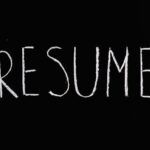Before diving into the specifics of what to put on resume, it’s important to understand the primary purpose of a resume. A resume is a marketing tool that highlights your skills and experiences, aiming to secure an interview. It should provide a snapshot of your professional journey, demonstrating why you are the ideal candidate for a job.
Marketing Your Personal Brand – how to right a resume
A resume serves as a personal branding document that sets you apart from other candidates. It’s your opportunity to communicate your unique value proposition to potential employers. Think of it as your personal advertisement that tells employers why they should choose you over others. By carefully selecting the information to include, you create a powerful narrative that positions you as the perfect fit for the job.
The Interview Invitation
The ultimate goal of a resume is to secure an interview. It should pique the interest of hiring managers and entice them to learn more about you. This means it must be engaging enough to make them want to delve deeper into your qualifications during an interview. Each element of your resume should work together to create a compelling story that leaves employers eager to meet you in person.
Reflecting Your Professional Journey
Your resume is a reflection of your professional journey, showcasing where you’ve been and hinting at where you’re headed. It should highlight significant milestones, achievements, and growth over time. By effectively narrating your career path, you demonstrate your evolution as a professional, which can be a compelling factor for employers looking for candidates who are driven and ambitious.
How to right a resume – List the categories of information found in a résumé
Contact Information
The first thing on your resume should be your contact information. This section should include:
- Full Name: Your full legal name.
- Phone Number: A number where employers can easily reach you.
- Email Address: A professional email address, ideally one that includes your name.
- LinkedIn Profile: If applicable, include a link to your LinkedIn profile or any professional social media profiles relevant to your industry.
Ensure that your contact information is accurate and up-to-date. It should be easy to find, typically at the top of the resume.
Crafting a Professional Email Address
Your email address is often the first digital impression you make on potential employers. It should be professional and ideally incorporate your name to make it easy for employers to remember. Avoid using outdated or quirky email addresses, as they can come across as unprofessional. If necessary, create a new email account specifically for job applications to ensure professionalism.
The Power of LinkedIn
Including a link to your LinkedIn profile can greatly enhance your resume. LinkedIn is a powerful professional networking tool that allows employers to see recommendations, endorsements, and a more comprehensive view of your career. Keep your LinkedIn profile updated and ensure it reflects the information on your resume. This consistency builds trust and reinforces your professional image.
Accessibility and Accuracy
Accurate and accessible contact information is crucial for employers to reach you easily. Double-check your phone number and email address for typos, as a small mistake could mean missing out on a job opportunity. Format your contact information clearly, using a larger font or bold text to ensure it stands out at the top of your resume, making it easy for employers to contact you.
Professional Summary or Objective
A professional summary or objective is a brief section that gives an overview of who you are professionally.
Professional Summary
A professional summary is ideal for experienced professionals. It highlights your key achievements and skills in two or three sentences.
“Results-driven marketing specialist with over five years of experience in digital marketing and campaign management. Proven track record in increasing company revenue by over 20% through strategic planning and execution.”
Distilling Your Achievements
Your professional summary should distill your most significant achievements into a concise narrative. Focus on quantifiable results that demonstrate your impact in previous roles. This not only shows your competence but also your ability to drive tangible outcomes, making you an attractive candidate for employers seeking results-oriented individuals.
Highlighting Core Competencies
In addition to achievements, your summary should highlight your core competencies. These are the skills and attributes that define your professional expertise. Whether it’s leadership, project management, or technical skills, showcasing these in your summary helps employers quickly identify your strengths and how they align with the job requirements.
Crafting a Compelling Narrative
Your professional summary should tell a compelling story about your career journey. Use this space to weave together your experiences and skills into a narrative that captivates the reader. A well-crafted summary sets the tone for the rest of your resume, encouraging employers to continue reading and learn more about your qualifications.
Objective Statement
If you’re new to the workforce or switching careers, an objective statement can be more appropriate. It briefly outlines your career goals and what you hope to achieve in the role.
“Recent graduate with a degree in communications, seeking to leverage skills in content creation and social media management to contribute to a dynamic marketing team.”
Aligning Goals with Employer Needs
An effective objective statement aligns your career goals with the needs of the employer. Research the company and position to understand their objectives and challenges. Tailor your objective statement to reflect how your aspirations can help the organization achieve its goals, demonstrating your enthusiasm and commitment to their success.
Showcasing Your Unique Value
Even if you’re new to the workforce, your objective statement should showcase the unique value you bring. Highlight any relevant skills, experiences, or education that make you a valuable asset to the employer. This could include internships, volunteer work, or coursework that aligns with the job requirements, providing a glimpse of your potential impact.
Transitioning with Purpose
For career changers, the objective statement is an opportunity to explain your transition. Clearly articulate why you’re making the switch and how your past experiences are applicable to the new field. By demonstrating a clear purpose and transferable skills, you reassure employers of your capability to succeed in the new role.
Work Experience
Work experience is often the most crucial part of a resume. It should include:
- Job Title: Your role in the organization.
- Company Name: The name of your employer.
- Location: The city and state where you worked.
- Dates of Employment: The month and year you started and ended each job.
- Key Responsibilities and Achievements: Use bullet points to highlight your duties and accomplishments. Focus on quantifiable achievements, such as “Increased sales by 15% through targeted marketing campaigns.”
Tips for Listing Work Experience
- Use action verbs like “led,” “developed,” or “implemented” to describe your duties.
- Tailor this section to the job you are applying for by emphasizing the most relevant experiences.
- Keep descriptions concise and to the point.
Choosing the Right Action Verbs
Action verbs infuse your resume with energy and clarity, making your accomplishments stand out. Words like “led,” “developed,” and “implemented” convey authority and initiative, suggesting that you are proactive in your roles. Use varied action verbs to keep the reader engaged and provide a dynamic account of your responsibilities.
Tailoring Your Experience
Each job application is unique, and your resume should reflect that. Customize your work experience section to highlight the most relevant experiences for the position you’re applying to. Study the job description carefully and prioritize experiences that match the required skills and qualifications, increasing your chances of catching the employer’s attention.
Concise and Impactful Descriptions
While it’s important to provide enough detail to convey your responsibilities, brevity is key. Use bullet points to present information clearly and avoid overwhelming the reader with lengthy descriptions. Focus on impactful achievements rather than mundane tasks, and quantify your accomplishments whenever possible to provide measurable evidence of your contributions.
Education
List your educational background, including:
- Degree(s) Earned: For example, Bachelor of Arts in English.
- Institution Name: The name of the college or university.
- Location: The city and state of the institution.
- Graduation Date: The month and year you graduated.
If you graduated with honors or had a particularly high GPA, you might consider including that information as well.
Highlighting Academic Achievements
Your education section is not just about listing degrees; it’s an opportunity to highlight academic achievements that set you apart. If you graduated with honors, received academic awards, or maintained a high GPA, consider including these details. They showcase your dedication, intellect, and ability to excel in challenging environments, qualities that are attractive to employers.
Relevant Coursework and Projects
For recent graduates or those with limited work experience, including relevant coursework or projects can add value to your resume. Highlight classes or assignments that are directly related to the job you’re applying for. This not only demonstrates your knowledge in the field but also your ability to apply theoretical concepts to practical situations.
Continuing Education and Certifications
In today’s rapidly evolving job market, continuous learning is highly valued. If you’ve pursued additional certifications or courses beyond your formal education, include them in this section. Whether it’s an online course or a professional certification, these credentials demonstrate your commitment to staying current in your field and enhancing your skill set.
Skills
The skills section should showcase your abilities relevant to the job. Include both hard skills (technical abilities) and soft skills (interpersonal abilities).
Examples of Skills
- Technical Skills: Proficient in Adobe Creative Suite, Data Analysis, Coding in Python.
- Soft Skills: Strong communication, Leadership, Problem-solving.
Tailor this section to match the skills listed in the job description. This will not only make your resume more relevant but also increase your chances of passing through Applicant Tracking Systems (ATS).
Balancing Hard and Soft Skills
A well-rounded candidate possesses a blend of hard and soft skills. While technical skills demonstrate your ability to perform specific tasks, soft skills highlight your interpersonal abilities and how you interact with others. Employers value candidates who can balance both, as they indicate a candidate who is not only competent but also collaborative and adaptable.
Tailoring Skills to the Job
Carefully review the job description and identify key skills that the employer is seeking. Tailor your skills section to align with these requirements, using the same terminology to increase your chances of passing through ATS. By mirroring the language used in the job listing, you demonstrate that you possess the qualifications the employer is looking for.
Demonstrating Proficiency Levels
For technical skills, indicate your level of proficiency. Whether you’re a beginner, intermediate, or expert, providing this information gives employers a clearer understanding of your capabilities. This transparency builds trust and helps employers assess how you might fit into their team and contribute to their projects.
Certifications and Awards
If you have additional certifications or have received awards, include them in a separate section. This could include:
- Certifications: Such as Certified Public Accountant (CPA), Project Management Professional (PMP), etc.
- Awards: Like Employee of the Month, any industry-specific awards, etc.
Listing certifications and awards can demonstrate your commitment to the field and highlight your expertise.
Showcasing Industry Recognition
Awards and certifications are a testament to your expertise and commitment to your field. They signal to employers that you are recognized by your peers and industry leaders as a knowledgeable and accomplished professional. Include any industry-specific awards or recognitions that validate your skills and dedication to your profession.
Highlighting Ongoing Professional Development
Certifications reflect ongoing professional development and a commitment to continuous learning. They indicate that you are proactive in keeping your skills up-to-date and relevant in a constantly changing job market. Employers appreciate candidates who invest in their own growth, as this often translates to a motivated and adaptable employee.
Differentiating Yourself from Competitors
In a competitive job market, certifications and awards can differentiate you from other candidates. They add credibility to your resume and provide tangible proof of your abilities and achievements. Including these credentials can give you an edge over candidates with similar experiences but lacking the same level of recognition.
Volunteer Experience
If applicable, include volunteer experience that relates to the job you’re applying for. This can be particularly useful for those who have less professional experience. Include:
- Organization Name: The name of the non-profit or group.
- Role: Your position or the nature of your involvement.
- Dates of Involvement: The time period you volunteered.
- Key Contributions: Highlight any significant contributions or achievements during your volunteer work.
Leveraging Volunteer Work
Volunteer work can be a valuable addition to your resume, especially if it aligns with the job you’re applying for. It demonstrates your willingness to contribute to your community and develop skills outside of a traditional work setting. Highlighting relevant volunteer experience shows employers that you are proactive, community-minded, and possess transferable skills.
Highlighting Transferable Skills
Volunteer roles often require skills that are transferable to the workplace, such as leadership, communication, and project management. When detailing your volunteer experience, focus on these transferable skills and how they relate to the job you’re targeting. This approach helps employers see the value you bring, even if the experience wasn’t paid.
Demonstrating Passion and Commitment
Volunteering showcases your passion and commitment to causes that matter to you. Employers value candidates who are driven by more than just a paycheck, as it often translates to motivated and engaged employees. By including volunteer experience on your resume, you communicate your dedication to making a positive impact, both personally and professionally.
Additional Sections
Depending on your experience and the job you are applying for, you may consider adding additional sections, such as:
- Languages: List any languages you are fluent in.
- Projects: Describe any significant projects you have worked on.
- Professional Affiliations: Include any memberships in professional organizations.
Showcasing Language Skills
In an increasingly globalized world, language skills can be a major asset. If you’re fluent in more than one language, include this information on your resume. It demonstrates your ability to communicate across cultures and potentially opens doors to opportunities in international markets or companies with a diverse workforce.
Highlighting Significant Projects
Projects can be a great way to showcase your skills and accomplishments, especially if they are relevant to the job you’re applying for. Whether it’s a personal project or one completed during your education or previous employment, detailing your involvement and outcomes can highlight your initiative, problem-solving abilities, and technical expertise.
Professional Affiliations
Being part of professional organizations indicates that you are engaged with your industry and committed to your professional development. List any relevant memberships and your involvement level, whether it’s attending conferences, participating in committees, or contributing to publications. This demonstrates your dedication to staying informed and connected within your field.
Formatting Tips
- Consistency: Use the same font and style throughout.
- Readability: Keep your resume to one page, if possible, especially if you have less than 10 years of experience.
- Clarity: Use clear headings and bullet points to make information easy to digest.
- Professionalism: Avoid using overly decorative fonts or colors.
Ensuring Consistency
Consistency in formatting is key to maintaining a polished and professional appearance. Use the same font, size, and style for headings and text throughout your resume. This uniformity helps create a cohesive and organized document, making it easier for employers to navigate and find the information they need.
Optimizing Readability
Readability is crucial in ensuring your resume is quickly and easily understood. Use a clear, legible font and avoid clutter by keeping your resume to one page, particularly if you have less than a decade of experience. White space, bullet points, and concise wording contribute to a clean layout that invites employers to read further.
Maintaining Clarity and Professionalism
Clarity and professionalism are essential in making a strong first impression. Use clear headings and bullet points to break down information into digestible sections. Avoid using decorative fonts or excessive colors, as they can distract from the content. A straightforward, professional design enhances the credibility of your resume and reflects your attention to detail.
Final Thoughts
Creating a strong resume is crucial to making a good first impression with potential employers. By including these essential elements, you’ll ensure your resume is comprehensive, professional, and tailored to the job you want. Remember, the goal is to present a clear picture of your skills and experiences, making it easy for employers to see why you are the best candidate for the job.
Emphasizing Personal Branding
Your resume is more than a list of experiences; it’s a reflection of your personal brand. Every section should contribute to a cohesive narrative that highlights your unique value. Be intentional about the information you include and how you present it, ensuring that it aligns with your career goals and the image you wish to project to potential employers.
Tailoring to Your Audience
Each job application presents a unique audience with specific needs and expectations. Tailor your resume to each role by emphasizing the most relevant experiences, skills, and achievements. This customization demonstrates your genuine interest in the position and increases your chances of standing out in a competitive job market.
Continuous Improvement
A resume is a dynamic document that evolves with your career. Regularly update it to reflect new experiences, skills, and accomplishments. Seek feedback from peers or mentors to identify areas for improvement. By continuously refining your resume, you ensure it remains an accurate and compelling representation of your professional journey.
With these guidelines, you’re well on your way to crafting a resume that opens doors to new opportunities. Good luck!






